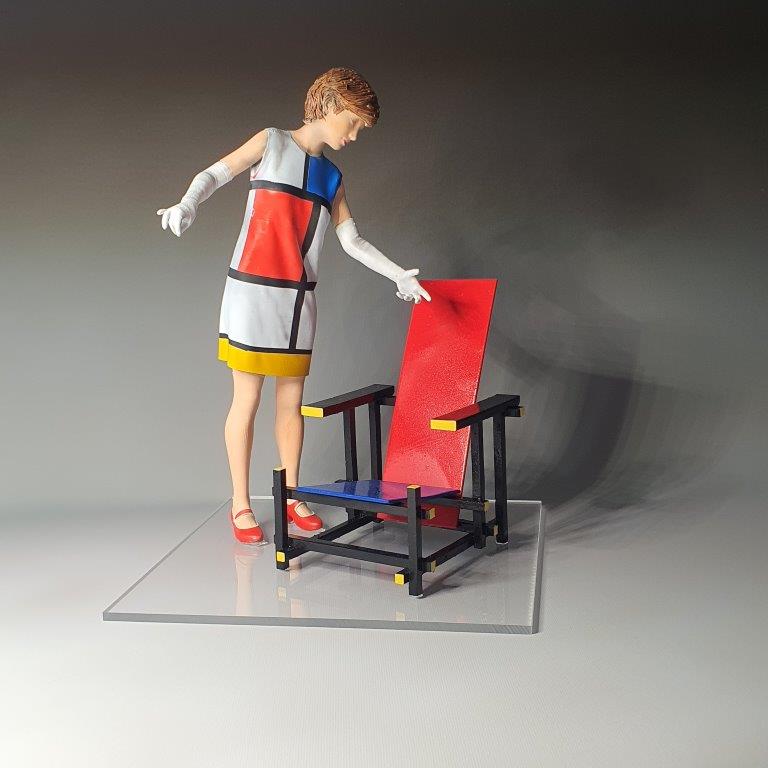
Yves Saint Laurent's Mondrian Dress and The Red and Blue Chair, designed by Gerrit Rietveld
Yves Saint Laurent's Mondrian Dress. Fashion, as an art form, often intersects with other creative domains to create something truly innovative and captivating. One such masterpiece of this intersection is Yves Saint Laurent's iconic Mondrian dress. Designed in 1965, this dress pays homage to the Dutch abstract painter Piet Mondrian and exemplifies the seamless connection between art and fashion.
Piet Mondrian was renowned for his geometric, abstract art, characterized by primary colors and rectangular forms. His work's influence on Saint Laurent was profound, leading to the creation of this groundbreaking dress. Yves Saint Laurent translated Mondrian's artistic vision into fashion with a dress that brought the canvas to life. The dress features a grid of thick black lines outlining blocks of primary colors – red, blue, and yellow. These color blocks are a direct reference to Mondrian's signature aesthetic. Saint Laurent's design simultaneously pays tribute to the art world and paves the way for a new era in fashion.
The Mondrian dress is an embodiment of the 1960s fashion movement. It is a testament to how fashion can be a powerful mirror reflecting the cultural and artistic zeitgeist of its time. The swinging '60s were marked by a rebellion against the traditional and a celebration of youth and innovation. Saint Laurent's Mondrian dress is the embodiment of this spirit, breaking away from the conventional and embracing a bold, forward-looking aesthetic.
Yves Saint Laurent's design philosophy always sought to empower women through clothing. The Mondrian dress does exactly that. It is not merely a piece of art but a wearable work of art. Its simple yet striking design allows the wearer to make a statement without uttering a word. By incorporating Mondrian's art into fashion, Saint Laurent democratized high art, making it accessible to a broader audience.
The impact of the Mondrian dress is profound and far-reaching. It has been exhibited in museums and galleries worldwide, solidifying its place in both the fashion and art worlds. It also paved the way for the fusion of art and fashion that has since become a prominent trend in the industry.
In conclusion, Yves Saint Laurent's Mondrian dress is a testament to the power of fashion as an art form. It marries the aesthetics of Piet Mondrian's abstract art with the free spirit of the 1960s, resulting in a timeless piece that continues to inspire and influence the fashion world. This dress exemplifies how fashion can transcend its utilitarian purpose, becoming a canvas for artistic expression and a reflection of the cultural zeitgeist. Saint Laurent's fusion of art and fashion in the Mondrian dress continues to be celebrated as a symbol of creativity, innovation, and the enduring legacy of two artistic visionaries.
The Red and Blue Chair, designed by Gerrit Rietveld in 1917, is an iconic piece of furniture that has left an indelible mark on the history of design and the development of the De Stijl movement. This unique chair is a masterpiece of simplicity, form, and color, and it represents a revolutionary departure from conventional design aesthetics of its time.
Gerrit Rietveld was a Dutch furniture designer and architect who was a prominent figure in the De Stijl movement. De Stijl, which means "The Style" in Dutch, was an artistic movement that emerged in the early 20th century and aimed to reduce design to its essential elements. It sought to eliminate unnecessary ornamentation and use only primary colors, along with black and white, to create a harmonious visual language. The Red and Blue Chair exemplifies these principles.
At first glance, the Red and Blue Chair is a study in geometric abstraction. It consists of simple rectangular planes and lines that intersect to create a dynamic, three-dimensional form. The chair's frame is composed of rectilinear members painted in black, which define the structure. The seat and backrest are composed of flat, rectangular surfaces painted in bold primary colors – red and blue. These colors were intentionally chosen by Rietveld as they represented the primary elements of his palette, which is central to the De Stijl movement's aesthetic.
Beyond its visual simplicity, the Red and Blue Chair is also an exercise in structural innovation. Rietveld rejected traditional joinery methods in favor of exposed, overlapping joints. This construction method, along with the use of color, was a bold departure from the norms of furniture design at the time. It highlighted the construction process itself, laying bare the chair's framework and revealing its structural integrity. This deconstruction of the traditional design process was groundbreaking and showcased the shift towards a more functional and honest approach to design.
The Red and Blue Chair's enduring appeal lies in its ability to capture the essence of De Stijl. It serves as a representation of the movement's fundamental principles: the use of primary colors, geometric abstraction, and the reduction of design to its essentials. Its timeless design has made it a celebrated icon in the world of modern furniture, and it continues to inspire designers and artists today.
In conclusion, Gerrit Rietveld's Red and Blue Chair is a triumph of design that encapsulates the ideals of the De Stijl movement. Its iconic use of primary colors, geometric forms, and innovative construction methods have solidified its place in the annals of design history. The Red and Blue Chair remains an enduring symbol of modernist design, reminding us of the power of simplicity and the importance of breaking free from tradition to create something truly groundbreaking.